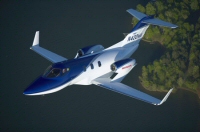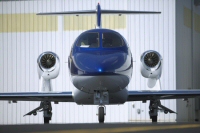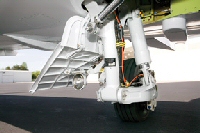 |
 |
 |
 |
 |
 |
 |
 |
An exclusive first look at a most unusual airplane
The question these days is not whether the Japanese automotive manufacturers will enter the general aviation market, but when. Toyota certified an aircraft variant of its Lexus automotive engine in the 1990s, but never put it into production. Toyota for a number of years flew a high-performance single-engine airplane in Southern California. Honda built and flew for some 170 hours a twin-engine six-seat composite business jet at Mississippi State University from 1993 through 1996. Honda Aero, a subsidiary of Honda Motor, last year signed a 50-50 partnership arrangement with General Electric to develop, certify, and manufacture a line of turbine engines designed by Honda. Honda and Continental Motors signed an agreement in 2003 to study the marketplace for a four-cylinder, liquid-cooled avgas engine designed by Honda. Meanwhile, in Greensboro, North Carolina, Honda R&D Americas has stealthily been flying the HondaJet, a new-generation light business jet powered by a pair of the new engines.
While GE Honda Aero Engines is the only entity to formally announce manufacturing plans, the HondaJet is a refined prototype that could easily slip into a certification and manufacturing program. At this point, the company's official word is that the airplane is a research project only.
However, during AOPA Pilot's exclusive interviews with the jet's designer, it became clear that he and others on the design team believe the airplane could be certified, and they appear ready and anxious to begin that process once the green light comes from Japan. To test the public's reaction to the unusual aircraft, the HondaJet was scheduled to make about a three-hour visit to EAA AirVenture 2005 in Oshkosh — the airplane's first public showing.
The HondaJet first flew on December 3, 2003, just two weeks before the centennial of flight. As of mid-April when Pilot visited the development facility in Greensboro, the airplane had accumulated more than 120 flight hours; the company estimates it will need about 200 flight hours to demonstrate and verify the design and performance capabilities.
As it has with its other product lines, Honda is taking its time in developing its aviation business. Honda studied the pickup-truck market and tested prototypes for more than 20 years before releasing the Ridgeline this year.
Unconventional thinking
As it did with the unusually shaped and unusually featured Ridgeline, Honda doesn't hesitate to forge a new direction in markets where it feels it can make a difference. Honda tends to enter markets only when it can produce a product that performs better and at a higher value than other products in that category. In fact, the stated goals for the HondaJet project are to develop a lightweight business jet with a larger cabin, lower fuel consumption, and higher speed than existing business jets. If the test results hold true, it appears to be on that path with the HondaJet. The company says the five- to six-seat airplane will cruise at 420 knots at 30,000 feet and fly as high as 41,000 feet while maintaining a cabin pressure of 8,000 feet. Each Honda HF118 turbofan engine produces 1,670 pounds of static thrust (lbst) at takeoff. Slightly smaller overall than the Cessna CJ1+, the HondaJet cruises 10 percent faster, has a cabin that is 30 percent larger, and has a range about 40 percent greater on about 14 percent less thrust. Although no one at Honda will commit to a price — stressing once again that the company considers this a research project at this point — some in the company suggest the price would be in the $3 million-to-$4 million range, compared to a Cessna CJ that starts at about $4.1 million.
Those who believe the Wright brothers used up all the magic back in 1903 may be wondering how a company can coax such greater performance out of an airframe and engines. Mostly it was that unconventional line of thinking that caused HondaJet designer Michimasa Fujino to look beyond what others have done to find ways to eke a bit more speed and economy from the airframe. Among the new technologies are a Honda-developed natural laminar-flow wing section, dubbed the SMH-1 design; a laminar-flow nose section that reduces drag on the fuselage; an over-the-wing engine mount, which also reduces drag; an aluminum main wing that uses an integrally stiffened skin, resulting in a smooth wing surface — helping to preserve the laminar flow; and a co-cured composite fuselage that provides a light structure and greater interior volume for a given cross section.
Facing Donald Trump
So what does your boss at your overall conservative company say when you walk in with such an unusual design? "You're fired" — almost. "I was almost fired when I first proposed this configuration," confessed Fujino. "It was very controversial. The data helped me convince them. But finally I just do what I think is best and right because top management trusted me and let me do whatever I want to do.
"Honda was very willing to allow me to try new things. I'm not sure an aircraft manufacturer would allow this."
Fujino began his career at Honda working on automotive systems, especially anti-lock braking systems. When Honda launched an aviation design unit in the mid-1980s he began work there at the bottom, sanding molds and laying up prepreg composites at Mississippi State University where the company developed the MH02, a strange-looking high-wing jet with two engines mounted above the wings. The airplane flew 170 hours but has since been placed in a museum in Japan. "Many designers don't have that kind of experience, so that will help me," Fujino said. He describes aircraft design as much more challenging than auto design, given the criticality of weight control and the extreme environmental issues facing aircraft.
The most unusual design feature of the HondaJet is the over-the-wing engine mount (OTWEM in Honda parlance). Fujino estimates he spent two to three years working on this one concept alone, bucking traditional wisdom that said putting anything on the trailing edge of the wing would induce unacceptable drag, never mind the heavy structure necessary to support an engine and its vibration and thrust loads. But after years of study, computer modeling, and wind-tunnel testing, Fujino found an optimal placement for the engine pylons that not only doesn't increase drag, it actually decreases drag relative to an airplane with empennage-mounted engines.
As it turns out, finding just the right spot and shape for the pylons was only half the battle. Flutter characteristics of such a mounting scheme are also critically important. Engine vibration and thrust loads if not properly managed can set up flutter that interacts with the flutter associated with the wing's normal bending moment. If flutter from the two areas is not compatible throughout the flight envelope, they can tear each other apart.
Again, after much testing, Fujino and his team found the right stiffness for the engine mount to assure compatibility.
A wing and a dare
Natural laminar flow (NLF) airfoils reduce drag by keeping the airflow attached to the wing surface to a greater degree of chord than do other airfoils. The concept is not new; NACA, the predecessor to NASA, developed a series of NLF airfoils in the early 1940s. However, the early designs were particularly sensitive to leading-edge contamination from bugs, ice, and even rain. Even minimal contamination could dramatically increase drag, lowering speed and increasing fuel burn. In addition, the most efficient NLF designs used a thin wing — great for aerodynamics, but not good when you need a place to store fuel. Then you'd prefer a big, fat wing.
To meet the goals of the HondaJet project, Honda developed a new NLF airfoil. As reported in a paper by Fujino published in the Journal of Aircraft, the SHM-1 design "exhibits a high drag-divergence Mach number." In other words, the design delays the onset of the normal drag increase that occurs as speed increases toward Mach 1. The wing causes a small nose-down pitching moment, another important point for an NLF design. Finally, the thickness of the airfoil is 15 percent of the chord — fat, in other words — to accommodate the required fuel without increasing wing area. The design maintains laminar flow over 42 percent of the upper surface and, most unusually, a high 63 percent on the bottom of the wing.
Honda first conducted test flights of the wing design in 1996 when it modified the wing of a T-33 jet by bonding a polyurethane foam glove over the original metal wing and then laying a fiberglass skin of the SHM-1 design over the foam. Integrated sensors and infrared cameras were used to determine the laminar-to-turbulent boundaries.
Honda's decision to construct the fuselage entirely of composite materials has also helped it reduce drag and weight. Fujino estimates the fuselage weighs about 10 to 15 percent less than an aluminum fuselage of similar size.
What's most unusual about the fuselage is the construction method. The constant cross-section portion — where the passengers sit — is constructed somewhat like a conventional aluminum fuselage with frames and stringers, except the components are made of composite materials. The cockpit and tail section is a honeycomb-sandwich construction to maintain the compound curves, which are especially important for the laminar-flow nose. The sandwich and stiffened panels are co-cured in an autoclave to reduce weight and cost. Normally, such materials would need to be cured separately and then mated, but Honda developed a method whereby they can be cured at the same time.
The laminar-flow nose section appears a bit bulbous from the front, but then sculpts nicely inward near the cockpit bulkhead, giving the airplane a wasplike appearance in the forward section. The design reduces overall fuselage drag by some 10 percent, according to Fujino. The compound-curved windshields also improve aerodynamic characteristics. The protruding windshields give the airplane a bit of a bug-eyed look — cleverly diminished with the HondaJet's paint scheme — but make for very good visibility from the pilot seats.
The constant contour of the passenger compartment — made possible by the wing-mounted engine — provides a great deal of flexibility. Although the test airplane does not have a complete interior in it, I was able to sit in the aft seats. It is truly a spacious cabin. Because of the constant contour, interior designers can easily move the aft bulkhead forward or aft a frame or two in order to maximize either exterior baggage space or interior space. The cabin will easily seat four or five with room left over for a 26- or 28-inch lavatory, which is larger than you usually see in this class of airplane.
Up front, a Garmin G1000 integrated cockpit leads the way. Like many of the other systems, the flight control system is conventional and is manipulated by conventional yokes. Perhaps in deference to Fujino's work on automotive ABS, you stop the HondaJet using brake-by-wire — an electrically controlled hydraulically actuated system. Steering is through an electrically controlled, hydraulic system.
A low-profile, sturdy, trailing-link main-landing-gear system will be appreciated by pilots and passengers alike. As a result of the low profile, passengers can easily step into the airplane. The low profile also reduces weight and makes the leading edge of the wing only about thigh high. A simple free-fall system with a pressure pneumatic assist provides emergency gear extension capabilities.
The 2,300 pounds of fuel are stored in the wet wing and in a bladder tank under the fuselage.
Like most jets, it will have a stick-shaker to keep it out of a deep stall. However, based on simulator data, the airplane is recoverable from a deep stall, according to Fujino.
While we were not provided the opportunity to fly the prototype — yet, Atlantic Aero test pilots who have flown the airplane say it is nimble and well harmonized and lighter in roll than a CJ. Atlantic Aero, also based in Greensboro, is providing technical support to Honda, including flight crews.
Finding or making your niche
Given its size and performance, the HondaJet represents an interesting airplane that can perhaps play in both the emerging very light jet (VLJ) market and the maturing light jet market. With a maximum takeoff weight of 9,200 pounds, it is 3,500 pounds heavier than the Eclipse 500 and 1,600 pounds lighter than the CJ1+; Cessna and Adam Aircraft have not yet released weights for their Mustang and A700 VLJs, respectively. While it is certainly a larger airplane than the Eclipse, the HondaJet's Garmin G1000 will be familiar to many pilots transitioning into it from smaller airplanes, just as the Avidyne system in the Eclipse will be familiar to those moving into that airplane.
Fujino believes the HondaJet is a good compromise between light jets and VLJs, offering lower direct operating costs than light jets and better performance than both VLJs and light jets. However, he is not convinced the air-taxi concept touted by many as a new transportation system is going to completely develop, noting that there have been many assumptions made and very little investment in the infrastructure.
In discussing where the HondaJet project may go next, Fujino talks a lot about corporate responsibility. "People expect something from Honda," he says. "The reputation of Honda is very high.
"The role of Honda is to present new technology in the world to improve our future life. If people in the future desire this technology, maybe Honda has the responsibility to satisfy this need."
While that may be the official corporate word from Japan, there is no doubt that Fujino and his team believe they have created a product that could be successful, and it is definitely a product he is passionate about. "I always thought that airplane design was a kind of art and HondaJet is kind of my work of art. So I did my best from concept sketch to final painting," Fujino said, noting that the initial sketch was on the back of a calendar. "I think I was lucky to realize my concept and dream."
Perhaps sometime soon we'll learn whether his dream of producing a business jet will also come true.
E-mail the author at [email protected].
Links to additional information about the HondaJet may be found on AOPA Online ( www.aopa.org/pilot/links.shtml).
SPEC SHEET
| HondaJet No price established | |
|---|---|
| Specifications | |
| Powerplants | Two Honda HF118 turbofans, 1,670 lbst each |
| Length | 41 ft |
| Height | 13 ft 3 in |
| Wingspan | 39 ft 10 in |
| Seats | 5-6 |
| Maximum gross weight | 9,200 lb |
| Maximum takeoff weight | 9,200 lb |
| Fuel capacity, std | 2,300 lb |
| Performance | |
| Takeoff distance, ground roll | 2,647 ft |
| Max cruise speed, 30,000 feet | 420 KTAS |
| Range | 1,100 nm |
| Max operating altitude | 41,000 ft |
| Landing distance, ground roll | 2,277 ft |
| For more information, contact American Honda Corporate Affairs, 310/781-5542 or visit the Web site ( http://hondajet.honda.com). All specifications are based on manufacturer's calculations. All performance figures are based on standard day, standard atmosphere, sea level, gross weight conditions unless otherwise noted. | |



